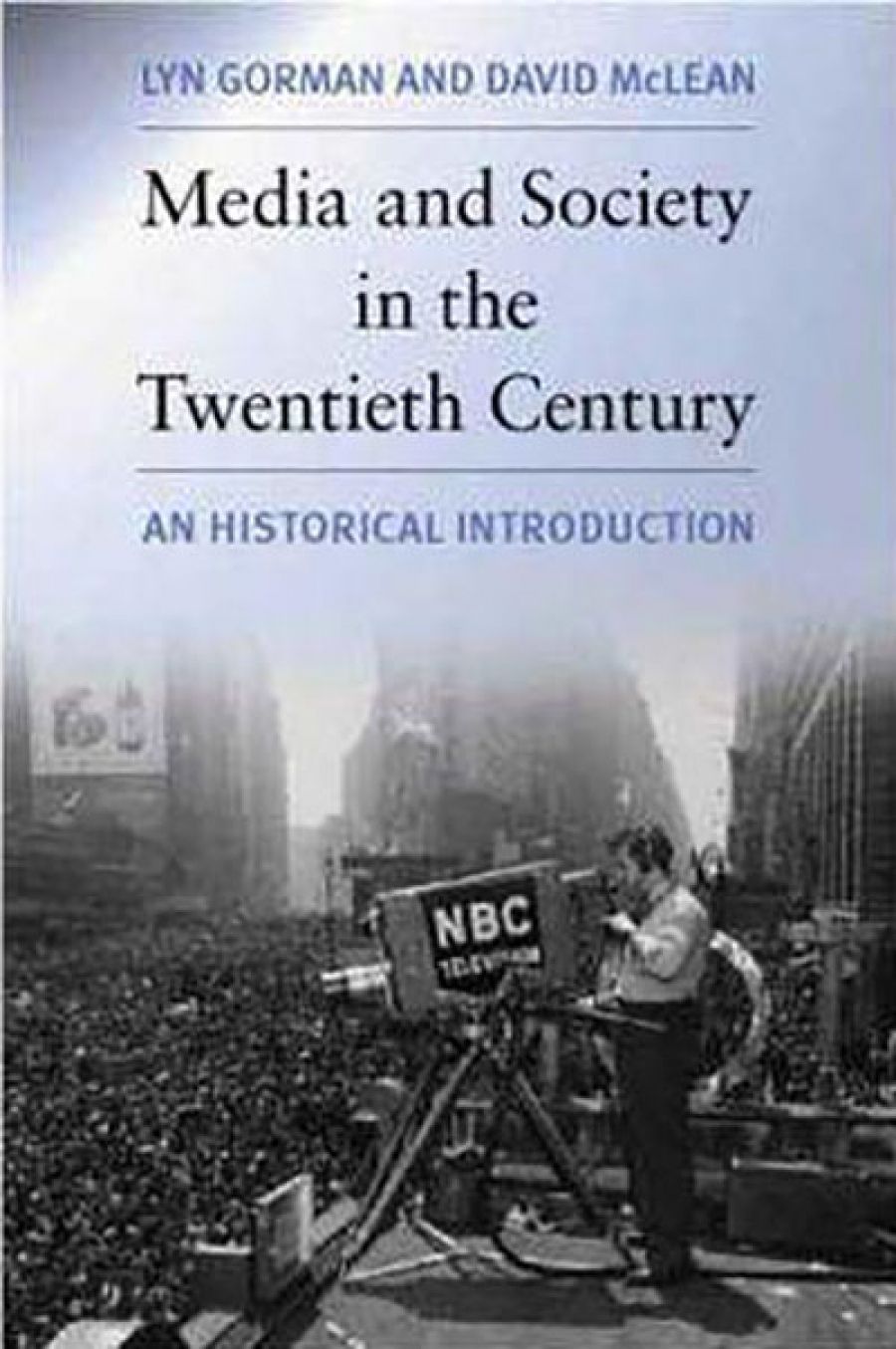
- Free Article: No
- Contents Category: Media
- Review Article: Yes
- Article Title: Media Massness
- Online Only: No
- Custom Highlight Text:
Media history is an oddly underdeveloped area. Historians who work in media history are frequently reminded that such work exists at the margins of their discipline, and media does not feature at all in many accounts of political and social history. To take one example, Alastair Davidson’s otherwise impressive From Subject to Citizen: Australian citizenship in the twentieth century (1997) contains one reference to Rupert Murdoch’s citizenship, but none to the role of media in forming the identities of Australian citizens in the twentieth century.
- Book 1 Title: Media and Society in the Twentieth Century
- Book 1 Subtitle: A historical introduction
- Book 1 Biblio: Blackwell Publishing, $58.25 pb, 284 pp
- Book 1 Readings Link: booktopia.kh4ffx.net/jW64WM
Where history is considered in media and communications studies, two approaches have tended to prevail. One is derived from Cultural Studies, where history constitutes a backdrop for the conflict of ideas – between postmodernism and critical theory, for instance – that is taken to be the real driver of change. The other is the dry mass communications approach where history becomes a history of media technologies, with each – print, film, radio, television, the Internet – making a cameo appearance, and no strong sense emerging as to how these cohere with the overall social framework.
In this context, Lyn Gorman and David McLean’s book is a valuable contribution, and one that I hope will be widely adopted in media and communications courses. While it has the narrative account common to the mass communication histories – with chapters focused on a medium such as print or film, or the emergence of a new media industry such as advertising – the authors present it in a manner that is very much attuned to the social and cultural contexts in which new media forms arose.
Gorman and McLean are also alert to academic debates about different media, without allowing their book to be overly bogged down in them. The chapter on advertising, for example, considers the criticism presented by writers such as John Kenneth Galbraith and Herbert Marcuse that advertising promotes false needs, before endorsing Michael Schudson’s more nuanced account of advertising’s relationship to emergent consumer society.
One interesting feature of this book is the significance it attaches to war as a driver of developments in communications media. Having previously considered the question of whether Hollywood films promoted a particular American world view, and the cultural significance of radio, the authors see the 1930s and 1940s as a period in which the capacity of media to be used as an instrument of mass persuasion was tested in the field in liberal democratic societies such as the USA, Great Britain, and Australia, as well as in the Soviet Union and Nazi Germany. The Cold War of the 1950s and 1960s is also presented as a key driver of global communications strategies of ‘cultural diplomacy’, and the significance of the Gulf War and the aftermath of the September 11 attacks on both media globalisation and the development of new techniques of media management is also considered in depth.
The authors consider twentieth-century, and indeed twenty-first-century, media developments across two evaluative axes. The first are variants of the ‘mass society’ or ‘ideological control’ thesis, where mass media are seen primarily as instruments of social control. The second are theories of cultural domination, where US-produced media are seen as instruments of hegemony and the exercise of ‘soft power’ in the global social order. Not surprisingly, the authors repeatedly indicate that such approaches greatly exaggerate the media’s capacity to shape attitudes and values.
Gorman and McLean nonetheless observe that the abiding virtue of theories of strong media power and influence is that they focus attention on both the specificities and significance of media as technological forms and cultural content. In light of a tendency in the humanities and social sciences to downplay the relevance of media as shapers of society, and the tendency of major media corporations to present what they do as merely producing another commercial commodity, media critics perform an important role in bending the stick in the other direction, posing normative questions about what social role media should play, and envisaging alternative arrangements for media production and distribution.
One issue that the book doesn’t consider at length is the role of media in the formation of citizen identities in the twentieth century. We know that acquiring literacy is never simply a matter of learning to read and write: it is a process in which we are immersed in a culture, a national identity and a language, and through which our subjective identities are shaped. The ‘mass-ness’ of media has been, in a crucial way, the manner in which it has helped to shape our identities as citizens, and the complex and often conflicting relationship such processes have had to those undertaken by the formal institutions of government and education. If globalisation and cultural fragmentation are two of the features distinguishing a twenty-first-century world, then global media are strongly implicated in both, and they operate in complex and sometimes antagonistic relations to the twentieth-century institutions of the nation state.
Media and Society in the Twentieth Century was written as a text to accompany courses in media history at Charles Sturt University. As such, it has the best attributes of a book targeted at the undergraduate student readership. Its coverage of developments is comprehensive, its treatment is concise, it doesn’t get bogged down in side issues, and the authors are always reminding the reader how particular issues connect up to a bigger picture. It also has what I consider to be the best attribute of a history book: its availability for repeated referencing. It should be taken up widely in the academic research community.


Comments powered by CComment